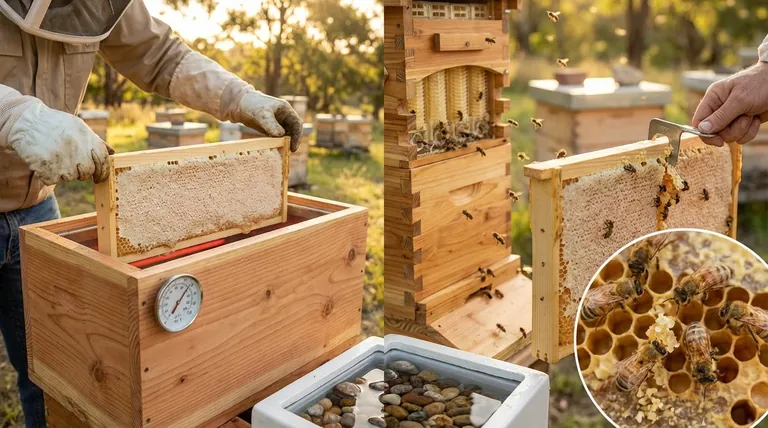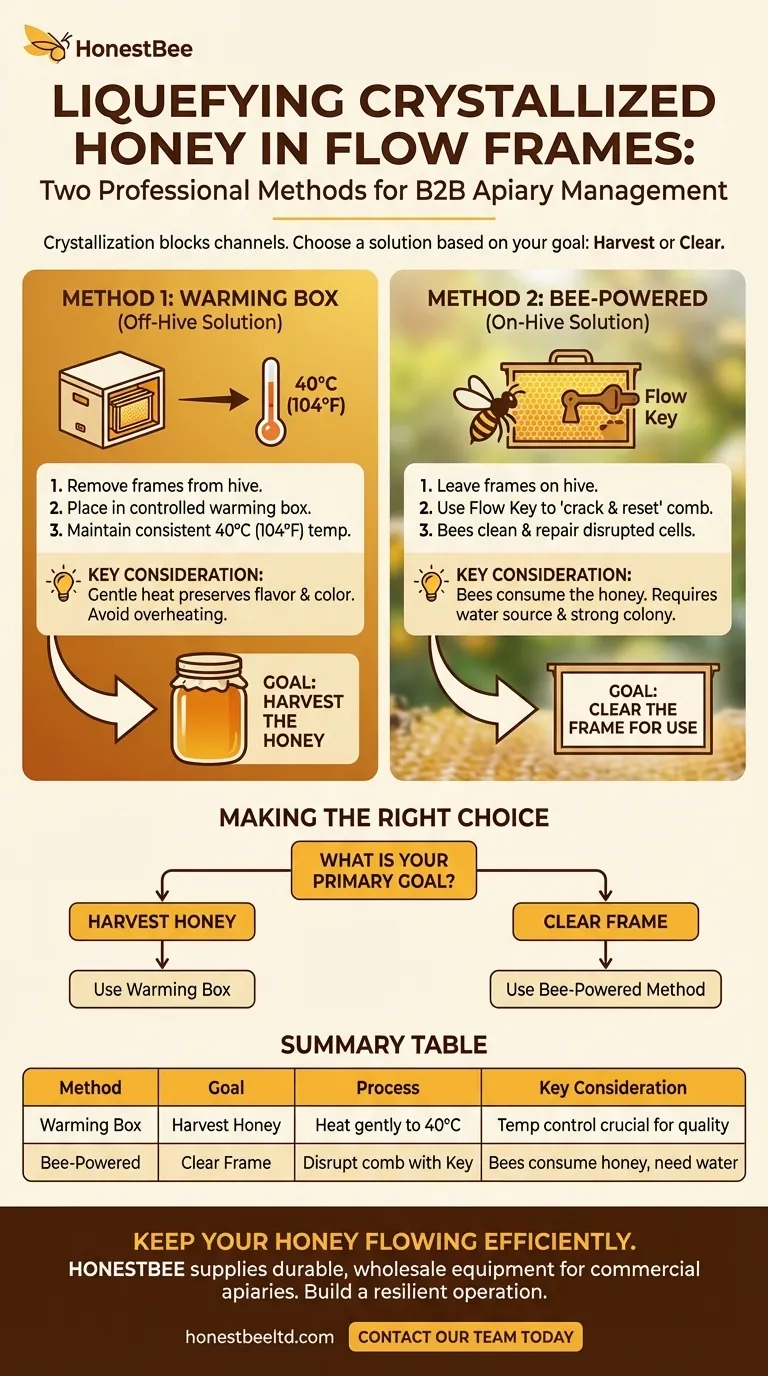To liquefy crystallized honey in Flow Frames, you have two primary methods. The first involves removing the frames from the hive and placing them in a warming box set to a controlled temperature. The second, an on-hive solution, involves using the Flow Key to disrupt the comb, which encourages the bees to clean out the crystallized honey themselves.
Crystallization physically blocks the channels in Flow Frames, preventing honey from being harvested. Your choice of solution depends on whether your goal is to harvest the crystallized honey (requiring external heat) or to simply clear the frame for future use (leveraging the bees).

Why Crystallization is a Problem for Flow Frames
The Mechanics of Flow Frames
Flow Frames are designed with partially formed honeycomb cells made of plastic. When you turn the Flow Key, the cells split vertically, creating channels that allow liquid honey to flow downwards and out of the hive for collection.
How Crystals Block the Flow
Crystallized honey, also known as granulated honey, is a natural process where the glucose in honey precipitates into solid crystals. These solid crystals physically obstruct the pre-formed channels within the plastic comb, making it impossible for the honey to drain when the frame is opened.
Method 1: Using a Warming Box (Off-Hive Solution)
The Principle of Gentle Heat
The solution to crystallization is gentle, controlled heat. Applying warmth melts the glucose crystals, returning the honey to its liquid state without damaging its flavor or color. This is the same principle used for reliquefying honey in a jar.
The Step-by-Step Process
To use this method, you must first remove the affected Flow Frames from the hive. Place them inside a warming box or a warm room where the temperature can be consistently maintained.
Why Temperature Control is Critical
The ideal temperature is 40°C (104°F). Exceeding this can cause the sugars in the honey to caramelize, altering the flavor and color. It is crucial to avoid rapid, uncontrolled heating, which is why microwaving is never recommended.
Method 2: Leveraging Your Bees (On-Hive Solution)
Triggering the Bees' Cleaning Instinct
This method uses the bees' natural tendency to maintain a perfect comb. By intentionally disrupting the crystallized cells, you signal to the colony that repairs are needed.
The "Crack and Reset" Technique
While the frame is still on the hive, insert the Flow Key into the upper slot. Turn the key to partially open and then close the frame. Repeating this a couple of times disrupts the wax cappings and the crystallized honey within the cells.
What the Bees Do Next
The bees perceive this disruption as a damaged comb. They will get to work uncapping the cells, removing the crystallized honey piece by piece, and repairing the comb structure. This effectively clears the frame so they can refill it.
The Importance of a Water Source
For this method to be successful, your bees must have access to a good quality water source. They will use the water to help dissolve and remove the hardened, crystallized honey from the cells.
Understanding the Trade-offs
The Warming Box Method
This is the only method that allows you to harvest the honey from the crystallized frame. However, it requires you to own or build a warming box and involves the labor of removing the frames from the hive.
The Bee-Powered Method
This approach requires no special equipment and is less disruptive to the hive structure. The major trade-off is that the bees will consume the honey they clean out; you will not be able to harvest it. This method's success also depends on the strength and behavior of your colony.
Making the Right Choice for Your Goal
By understanding the outcome of each method, you can select the one that best fits your immediate needs.
- If your primary focus is to harvest the honey in the frame: Use a warming box to gently liquefy the crystals, as this is the only way to preserve the honey for collection.
- If your primary focus is to clear the frame with minimal effort: Use the on-hive "crack and reset" technique and let the bees clean it out, accepting that they will use the honey themselves.
Choosing the right approach ensures you can effectively manage this common issue and keep your Flow Hive productive.
Summary Table:
| Method | Goal | Process | Key Consideration |
|---|---|---|---|
| Warming Box | Harvest the honey | Remove frames; heat gently to 40°C (104°F) | Requires temperature control to preserve honey quality |
| Bee-Powered | Clear the frame for future use | Use Flow Key to disrupt comb; bees clean crystals | Bees consume the honey; requires a strong colony & water source |
Keep your honey flowing efficiently. Whether you manage a few hives or a large commercial apiary, proper equipment is key to productivity. HONESTBEE supplies durable, wholesale-focused beekeeping supplies and equipment to commercial apiaries and distributors. Let us help you build a more resilient operation. Contact our team today to discuss your needs.
Visual Guide

Related Products
- Automatic Honey Flow Beehive 4 Frame Mini Hive for Beekeeping
- Wooden Bee Hive Frames for Beekeeping and Wholesale
- Professional Drop-Style Hive Handles for Beekeeping
- Copper Bee Frame Eyelets for Beekeeping
- HONESTBEE Professional Long Handled Hive Tool with Precision Cutting Blade
People Also Ask
- How long does it take to get honey from a Flow Hive? Fast Harvesting Explained
- How long does it take for bees to fill a Flow Hive? A Guide to Realistic Timelines
- What is the selling point of the Flow Hive? A Revolutionary, Stress-Free Honey Harvest
- How does the Flow Hive improve bee health? By Minimizing Stress During Honey Harvest
- What are the advantages of using an Auto Flow Hive? Experience Gentle, On-Tap Honey Harvesting



















